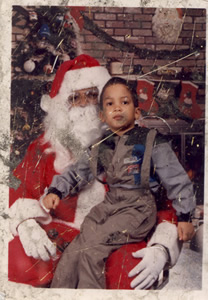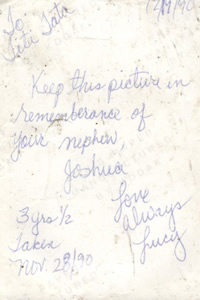
The Found Photograph and the Limits of Meaning
Barry Mauer
continued . . .
![]()
 When I look closely at found photographs, my attitude towards them changes. I become less like a voyeur and more like a detective. As a detective, I am interested in using the photographs as evidence to discover truth. I can discern the genre in most cases—studio portraits, industrial photographs, family photographs. I can usually discern the year the photograph was processed; many of them have processing dates stamped on the edge or on the back. Other types of information are more difficult to certify. Since I have no information about the people in the photographs beyond their images (only a couple of photographs have captions; the one above has writing on
When I look closely at found photographs, my attitude towards them changes. I become less like a voyeur and more like a detective. As a detective, I am interested in using the photographs as evidence to discover truth. I can discern the genre in most cases—studio portraits, industrial photographs, family photographs. I can usually discern the year the photograph was processed; many of them have processing dates stamped on the edge or on the back. Other types of information are more difficult to certify. Since I have no information about the people in the photographs beyond their images (only a couple of photographs have captions; the one above has writing on  the back: "12/19/90 To Titi Tata, Keep this picture in remembrance of your nephew, Joshua Love always Lucy 3 yrs 1/2 Taken Nov 28/90." I have to infer everything about the relationships, lifestyles, habits, and histories of the characters from the images and the fact of their loss. Who are the people in the photographs? what were their relations
to one another? who took the photographs? where? when? why? who owned them? how were they lost? why were they lost? what happened before and after the photographs were taken? where are these people now? do they want their photos back? My friends and I sometimes spend hours searching found photographs for clues, and the images reward this close attention with fascinating discoveries. My friends routinely raise questions, find details, and make inferences that I have missed.
the back: "12/19/90 To Titi Tata, Keep this picture in remembrance of your nephew, Joshua Love always Lucy 3 yrs 1/2 Taken Nov 28/90." I have to infer everything about the relationships, lifestyles, habits, and histories of the characters from the images and the fact of their loss. Who are the people in the photographs? what were their relations
to one another? who took the photographs? where? when? why? who owned them? how were they lost? why were they lost? what happened before and after the photographs were taken? where are these people now? do they want their photos back? My friends and I sometimes spend hours searching found photographs for clues, and the images reward this close attention with fascinating discoveries. My friends routinely raise questions, find details, and make inferences that I have missed.
1 | 2 | 3 | 4 | 5 | 6 | 7 | 8 | Next Node | 10 | 11 | 12 | Works Cited
|
Copyright © Enculturation 2001 |